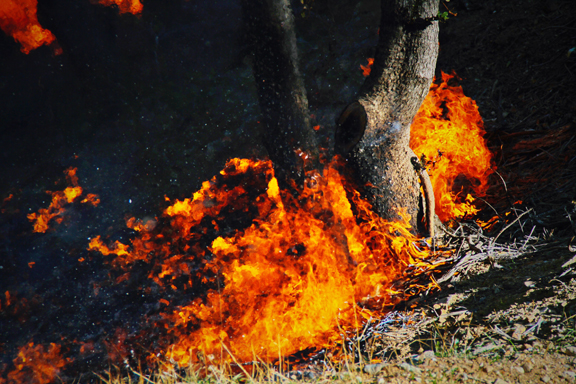
A burning tree during a prescribed burn under the supervision of the U.S. Forest Service.
By Charly SHELTON
Fire is part of California life. Fire is destructive, but makes rebirth possible. A consequence of not allowing anything to burn as part of a natural cycle is having large fires, like the ones we see now ravaging the state. But despite the President’s view expressed on Twitter that it is due to “gross mismanagement of the forests” that the fires are devastating the state, that’s not actually the case. Over the next three weeks, CV Weekly will take a look at some of the causes and outcomes of fire management in the local Angeles National Forest and in the towns and communities living in the foothills.
But first, we must know what fire does.
Fires are a natural process by which nature reinvigorates the soil with high-nutrient fertilizer and clears away dead detritus that may choke the living plants. Without fire, the dead plants would pile up and not allow new seeds to reach the forest floor. If the environment would be left to run its natural course, every few decades there would be a massive burn to clear out the clutter that would allow new life to spring forth. This becomes complicated when we put humans into the equation.
Native Americans of California still recall traditional lifeways where burning the hillside was part of the yearly calendar – like Lucy Thompson, a Yurok woman (northern California tribe near the area of Camp Fire) who, in the book, “The Way We Lived,” recalls that “In taking care of the hazel flats, they go out in the dry summer or early in the fall months and burn the hazel brush; then the next spring the young shoots start up from the old roots.”
The Karuk, the upriver neighbors of the Yurok, would burn the mountainside in September as a way to call the salmon back upriver, said Bill Tripp, a member of the Karuk tribe in an informative plaque at the Autry Museum of Western Heritage. “It’s said that the smoke carries the prayers, but the fire answers them. Part of that smoke going up would shade the river and it would cool the water temperature.”
Fire carries many benefits and responsible management of the land includes intentional burns that don’t get out of control, as was practiced for thousands of years in California. Today, the practice is continued by firefighting crews statewide in what are called prescribed burns – an intentionally set fire that can be controlled in a specific area and 100% contained before the fire begins. But in areas with homes, even a prescribed burn isn’t possible. These areas are dealt with what’s called mechanical treatment, or manually removing the fire fuels that have built up. This includes cutting down old trees, raking up detritus and creating safe fire boundary lines that are more difficult for wildfires to cross.
Local fire recovery specialist Paul Davis Restoration has put together a list of fire dos and don’ts in the case of a fire emergency reaching the home. The list, along with other tips, can be found by scanning the QR code attached to this story, or on the website CVWeekly.com.
Next week, we will take a look at fire management in the national forests.
